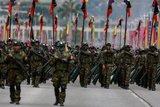Northrop’s IBCS shows long-distance capability
Northrop Grumman's Integrated Air and Missile Defense (IAMD) Battle Command System (IBCS) has successfully demonstrated the ability to scale up and network across long distances during a recent US Army-led test.
The evaluation was conducted over a five-week period with air and missile defense assets located at sites in New Mexico, Texas and Alabama.
As part of Soldier Checkout Event 4.0, the multi-node distributed test examined IBCS’ scalability, resilience and performance under stressing threat conditions. The open-architecture IBCS networked more than 20 nodes across White Sands Missile Range, New Mexico; Fort Bliss, Texas; and Redstone Arsenal, Alabama.
Integrated to operate as a single system, the test involved nine IBCS engagement operations centers and 12 IBCS integrated fire control network relays, along with Sentinel short-range air defence radars and Patriot radars, and Patriot Advance Capability Two (PAC-2), PAC-3 and PAC-3 Missile Segment Enhancement interceptors.
The test required IBCS to virtually form an IAMD task force to defend four critical assets while tracking red and blue fighter aircraft, cruise missiles and tactical ballistic missiles. Multiple two-hour scenarios were run to check IBCS abilities, including providing and managing a network to maintain voice, data and video connectivity; performing friend-or-foe identification of air objects and forming a single integrated air picture; and planning, executing and monitoring simulated threat engagements.
The test also included dynamically adding and removing nodes to confirm IBCS’ ability to self-configure as a mobile ad hoc network.
With IBCS, air and missile defence commanders can arrange forces over extensive distances using whatever means of communications that are available. Today, commanders are restricted by the proprietary and limited networks tied to the individual closed systems.
IBCS is the central component of the army’s future IAMD construct.
More from Digital Battlespace
-
![Babcock nears first customer for Nomad AI translation tool]()
Babcock nears first customer for Nomad AI translation tool
Nomad can provide militaries with real-time intelligence, saving critical time on the battlefield.
-
![AUSA 2025: Israel’s Asio Technologies to supply hundreds of improved Taurus tactical systems]()
AUSA 2025: Israel’s Asio Technologies to supply hundreds of improved Taurus tactical systems
Taurus operates alongside the Israel Defense Forces’ Orion system which supports mission management across tens of thousands of manoeuvring forces, from squad leaders to battalion commanders.
-
![AUSA 2025: Kopin pushes micro-LED plans as China moves faster]()
AUSA 2025: Kopin pushes micro-LED plans as China moves faster
The plan for the new displays follows fresh investment in Kopin’s European facilities by Theon and an order for head-up displays in fielded aircraft, with funding from the US Department of Defense.
-
![AUSA 2025: Persistent Systems to complete its largest order by year’s end]()
AUSA 2025: Persistent Systems to complete its largest order by year’s end
Persistent Systems received its largest ever single order for its MPU5 devices and other systems earlier this month and has already delivered the 50 units to the US Army’s 4th Infantry Division.
-
![Aselsan brings in dozens of companies and systems under the Steel Dome umbrella]()
Aselsan brings in dozens of companies and systems under the Steel Dome umbrella
Turkey has joined the family of countries attempting to establish a multilayered air defence system with government approval in August 2024 for the effort landed by Aselsan. Dubbed Steel Dome, the programme joins Israel’s Iron Dome, the US Golden Dome, India’s Mission Sudarshan Chakra and South Korea’s low-altitude missile defence system.
-
![DSEI 2025: MARSS unveils new agnostic multidomain C4 system]()
DSEI 2025: MARSS unveils new agnostic multidomain C4 system
MARSS’ NiDAR system has been deployed using sensors from static platforms to provide detection and protection for static sights, such as critical infrastructure, ports and military bases.




























